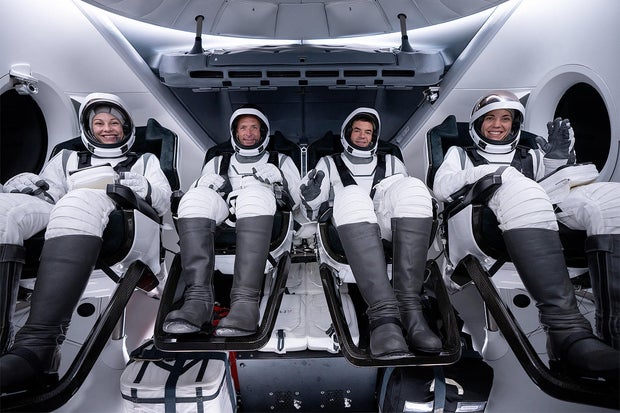The launch of four civilians on a privately chartered spaceflight — the Polaris Dawn, featuring the first commercial spacewalk — is on track for early Wednesday after a 24-hour delay to resolve a helium leak in a launch pad umbilical system.
Jared Isaacman, the flight’s billionaire commander, former F-16 pilot Scott Poteet and two SpaceX engineers, Anna Menon and Sarah Gillis, plan to blast off Wednesday at 3:38 a.m. EDT, kicking off a 12-minute climb to an elliptical orbit that will carry them higher than any astronauts have flown since the Apollo moon program.
SpaceX
The launch was originally planned for Monday, but the flight was delayed 24 hours to complete normal pre-flight processing. Another 24-hour slip then was ordered after engineers discovered a leak in a launch pad umbilical that delivers helium to the booster to push propellants to the rocket’s engines.
SpaceX does not normally provide details about such problems, but the company said Tuesday afternoon the Falcon 9 was on track for a pre-dawn Wednesday launch, with forecasters predicting an 85% chance of good weather along Florida’s Space Coast.
Downrange from the launch site, however, the company was keeping tabs on weather along the Falcon 9’s northeasterly trajectory, where the first stage booster will attempt to land on an offshore droneship after propelling the vehicle out of the lower atmosphere.
The flight is the second SpaceX trip to low-Earth orbit chartered by Isaacman, who at 16 founded what became one of the nation’s leading credit card transaction processors. In 2021, he financed and commanded the Inspiration4 mission, the first all-civilian commercial flight to orbit.
SpaceX
The Polaris Dawn mission launching Wednesday is the first of three more SpaceX flights Isaacman is funding in cooperation with company founder Elon Musk, and the first ever featuring non-government, civilian spacewalks.
Using a scaffold known as the “Skywalker,” Isaacman and Gillis will take turns floating up through the Crew Dragon’s forward hatch to reach open space early Friday, connected at all times by 12-foot-long tethers.
Because the ship does not have an airlock, its cabin will be vented to vacuum before the hatch is opened. Poteet and Menon will also be wearing SpaceX-designed pressure suits, and even though they will not get to stick their helmeted heads outside, they will be counted among the world’s spacewalkers.
The primary goals of the demonstration is to test the new suit’s joints, mobility and comfort to help SpaceX engineers develop lower-cost, easier-to-produce spacesuits for large numbers of people who SpaceX says will one day be venturing to the moon and Mars.
The crew also plans to test a high-speed laser communications system and will carry out a battery of bio-medical experiments throughout the five-day flight to help researchers from more than 30 institutions learn more about the effects of weightlessness.
The Polaris Dawn astronauts are expected to splash down off the coast of Florida on Labor Day.



